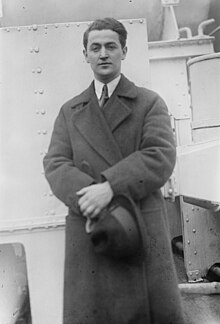Samuel Dushkin

Samuel Dushkin(December 13, 1891 – June 24, 1976) was an Americanviolinist,composer,andpedagogueofPolishbirth and Jewish origin.
Dushkin was born inSuwałki,Poland. He studied at theConservatoire de Paris,as well as withLeopold AuerinNew York CityandFritz Kreisler.He made his European debut in 1918 at the age of twenty-three, and six years later, his American debut with theNew York Symphony OrchestraunderWalter Damrosch.
Dushkin collaborated closely withIgor Stravinskyin the composition of the latter's first work for the violin, theViolin Concerto.He performed the concerto's world and US premieres, and on the debut Vox recording (VLP 6340) with Stravinsky conducting the Lamoureux Orchestra.
Stravinsky also composed hisDuo Concertanteand hisDivertimento,both for violin andpiano,to play with Dushkin on concert tours. They also worked together on violin transcriptions of other works, such as theSuite ItaliennefromPulcinella.
Dushkin gave the premiere of Ravel'sorchestralversion of hisTzigane,in Amsterdam on 19 October 1924, withPierre Monteuxconducting theConcertgebouw Orchestra.[1]
William Schuman's violin concerto, completed in 1947 in its original version, was the result of a commission from Dushkin that included a provision for the exclusive right to perform the work for three years. Schuman composed the concerto without ever having heard Dushkin perform publicly, and it proved too difficult. The premiere (given byIsaac Stern) was delayed until 1950 because Dushkin nevertheless insisted on maintaining his exclusive right to the work.[2]
Dushkin owned twoStradivariusviolins, aGuarneri del Gesùviolin and aGuadagniniviolin.[3]
Dushkin published many arrangements and transcriptions for violin and piano, for example, pieces byIsaac Albéniz,Georges Bizet,Rudolf Felber (1891-1978),George Gershwin,Paul Kirman,Modest Mussorgsky,Sergei Rachmaninoff,Igor Stravinsky,Henryk Wieniawskiand other composers. They are published as "Samuel Dushkin Repertoire".[4]He was also the author of the "Grave for violin and orchestra by Johann Georg Benda", and the "Sicilienne in E-flat Major by Maria Theresia von Paradis", bothmusical hoaxes.[5]
His younger brother, David Dushkin, also studied music in America and Paris. David, along with his wife, Dorothy, founded theMusic Institute of Chicagoin 1931, as well as the Kinhaven Music School in 1952.[6][7]
Dushkin died in New York in 1976.
Notes
[edit]- ^Canarina, John.Pierre Monteux, Maître.Pompton Plains, New Jersey: Amadeus Press, 2003, p341.
- ^Simmons, Walter (2017).The Music of William Schuman, Vincent Persichetti, and Peter Mennin: Voices of Stone and Steel.Lanham, Maryland: Rowman & Littlefield. p. 103.ISBN978-1-5381-0383-8.
- ^Cozio.comArchived2011-05-21 at theWayback Machine
- ^Birtel, Wolfgang, ed. (2008).Samuel Dushkin Repertoire.Mainz: Schott Music.ASINB00385LJZ4.OCLC605251001.
- ^Lebermann, Walter (1967)."Apokryph, Plagiat, Korruptel oder Falsifikat?]"[Apocrypha, plagiarism, corruption or falsification].Musikforschung XX.20(4): 413–425.JSTOR41116162.Retrieved20 January2023.
- ^"History".Kinhaven Music School.Retrieved18 March2016.
- ^"The Dushkins".Music Institute of Chicago.Retrieved18 March2016.
References
[edit]- "Samuel Dushkin" The Concise Grove Dictionary of Music. Oxford University Press, Inc., 1994
- Stravinsky, Igor (1958).An Autobiography.New York: M. & J. Steuer. pp. 165–168.Retrieved12 February2015.(Meeting with Samuel Dushkin)
External links
[edit]- Dorothy Dushkin papersat theSophia Smith Collection,Smith College Special Collections
